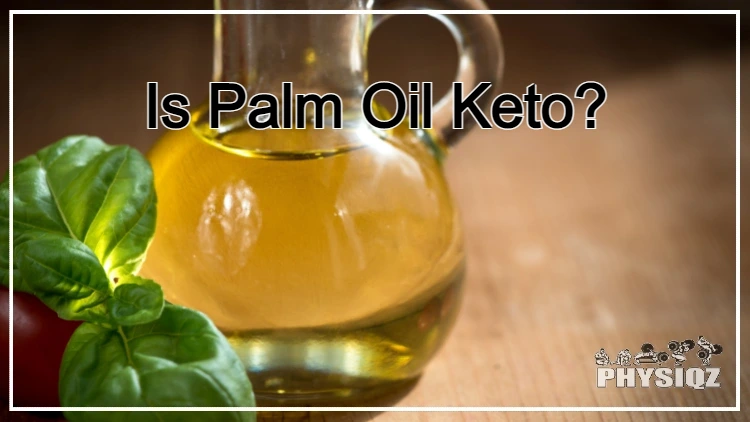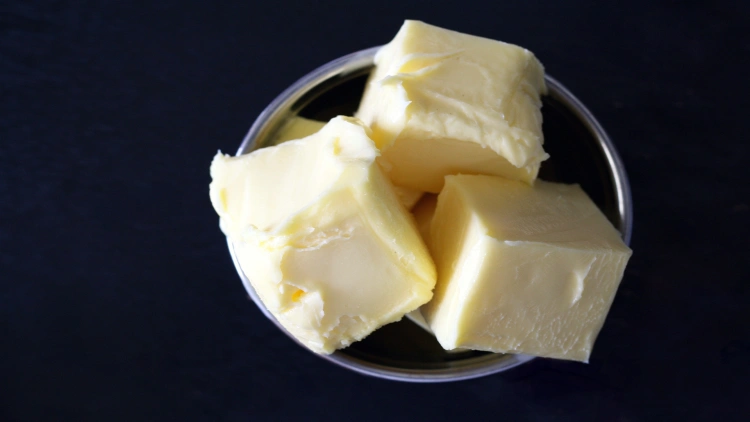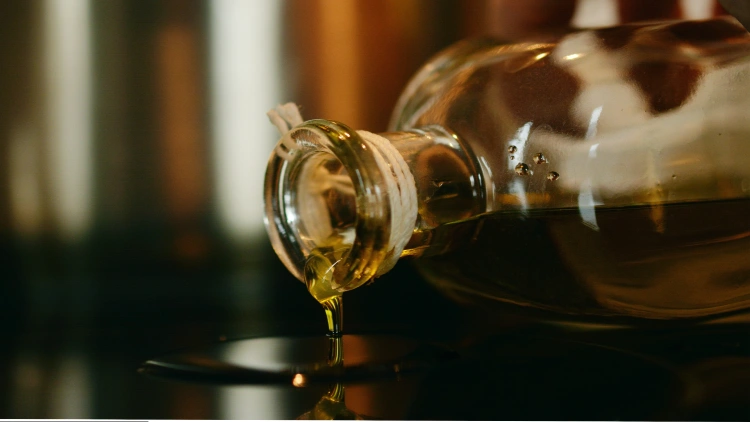
For individuals adhering to the ketogenic diet, determining which cooking oils align with daily carb limits can pose a challenge. We’ll explore palm oil’s suitability for this diet, discuss its environmental impact, and compare it with other commonly used oils for keto cooking.1
Although palm oil is keto, there are some environmental and human rights impacts that may make one hesitant to go with this option so we’ll offer plenty of other cooking oil suggestions that are better all around and won’t kick anyone out of ketosis. We’ll also cover their macros, flavors, and what we advise to use each one for.
How Many Carbs Are in Palm Oil?

Source: congerdesign from Pixabay2
Those following many weight loss diets–specifically the keto low carb diet–must keep a close eye on their carbohydrate consumption in foods and drinks. It can be easy to forget to pay attention to carbs in ingredients like butter or cooking oil, but these should certainly be included in one’s daily carb count.
That begs the question of which cooking oils are good for keto. Some of the most popular oils used for cooking, frying, and roasting include coconut oil, avocado oil, canola oil, and palm oil.3
While we’ll delve deeper into the nutritional values and carb counts of other oils below, our primary focus is how many carbs are in palm oil and those on keto may be pleased to learn that palm oil is completely free of carbohydrates, or has 0 carbs.
Palm Oil & Its Suitability for the Keto Diet
On the keto diet, adherents aim to limit their daily carbohydrate intake to 20-50g per day. With zero carbs and a glycemic index of zero, palm oil unequivocally fits within this dietary framework.
Palm Oil vs Coconut Oil vs Other Popular Cooking Oils
Now that we’ve established that palm oil on keto is completely acceptable due to its nonexistent carbs, let’s compare it to some other popular cooking oils to see which is best for keto. Since coconut oil tends to be used often on keto, we’ll compare and contrast palm oil vs coconut oil as well as avocado, canola, and sesame oils for their macros and give pros and cons of each.
As shown in the following table, the macros are identical across the board but this doesn’t mean that all of these cooking oils have the same nutritional value nor that they are all approved for the keto diet. Although they are all carb free, canola oil and sesame oil are usually very highly processed and advised against.
Palm oil, coconut oil, and avocado oil are all keto approved and have other nutrients and benefits as well.
Nutritional Information per 1 tablespoon serving size:
Regular Palm Fruit Oil
- Carbs= 0g
- Fat= 14g
- Protein= 0g
- Pros: Keto-approved, handles high heat well, rich in Vitamin E
- Cons: High in saturated fats, negative environmental impact
Unrefined Coconut Oil
- Carbs= 0g
- Fat= 14g
- Protein= 0g
- Pros: Ketogenic, aromatic tropical scent and flavor
- Cons: Can increase LDL or “bad” cholesterol
Avocado Oil
- Carbs= 0g
- Fat= 14g
- Protein= 0g
- Pros: Keto, extremely high smoke point, more heart healthy, increases HDL “good” cholesterol
- Cons: Increased risk of allergic reactions compared to other keto cooking oils
Canola Oil
- Carbs= 0g
- Fat= 14g
- Protein= 0g
- Pros: High in omega-3s and omega-6s, less saturated fats than most cooking oils
- Cons: Highly refined, so should be avoided or had in small amounts
Sesame Oil
- Carbs= 0g
- Fat= 14g
- Protein= 0g
- Pros: Contains heart-healthy fats, protects skin, reduces inflammation
- Cons: Often highly processed, high in calories, more likely than other oils to be allergenic
Why Palm Oil Is Problematic

Source: Syd Sujuaan from Unsplash4
There is major controversy concerning the deforestation of biodiverse rainforests for the purpose of planting palm trees for palm oil production. ince palm trees need warm, tropical environments to thrive and crude palm oil–made from the fleshy fruit of palm trees– is drastically increasing in demand worldwide, major companies are razing natural rainforests to create their own man-made plantations for mass-production and mass profits.
This is primarily happening in Indonesia and Malaysia, where the climate is optimal for palm trees, but this practice is, in turn, devastating the local people and environment as well as displacing countless native animals and destroying wildlife.
Many endangered species such as pygmy elephants, Sumatran rhinos, and orangutans live in these forests, so the impact is even more harmful.
On top of all of this, the greenhouse gas impact on the climate is extremely problematic and there are claims of worker exploitation and child labor in the deforestation efforts.
Although palm oil is not bad for keto, the practices being used to mass-produce, grow, and harvest the palm fruit to make the oil is more than just cause for concern–it is an urgent issue that needs to be addressed as humans, plants, animals, and the climate at large are all being harmed in favor of profits.
Is There an Environmentally Friendly Keto Variety of Palm Oil?
Although we’ve just covered how the topic of a major controversy going on right now is palm oil, keto approval and environmental benefits can both be met with one type of this oil. One particular variety that is okay for keto and is also environmentally friendly is known as red palm oil.
Red palm oil is another word for unrefined palm oil. The most common type of palm oil found in stores and used in households is highly processed and has a very light yellow or clear color.
However, when unprocessed, palm oil has a deeper red color reflective of the color of palm fruit flesh, hence the name.
Not only is red palm oil keto-approved and a much healthier option due to its lack of processing; it can also be reviewed by the Roundtable on Sustainable Palm Oil (RSPO) to ensure it meets environmentally friendly standards in regards to production and sourcing to guarantee that it is produced much more sustainably than in the previously mentioned practices.
The RSPO sets production standards for those growing palm trees and enacts strict policies for companies to stop deforestation and human rights abuses, sell only RSPO-certified palm oil worldwide, and encourages transparency in their practices, sourcing, and usage of palm oil.
They seek to not only reduce deforestation and environmental damage, but to actually reverse it.
Since RSPO is the global standard for palm oil, always be sure to buy unrefined red palm oil with an RSPO or CSPO (Certified Sustainable Palm Oil) certification on the label to ensure ketosis is maintained and that the palm oil being purchased is sustainable.
Best Cooking Oils for Keto
Now let’s jump into some of the best cooking oils for keto that can even be used on alternative trending diets due to their health benefits in contrast to many non ketogenic oils.
Extra Virgin Olive Oil
Those curious about the keto compatibility of olive oil will find it reassuring that extra virgin olive oil, the least processed and highest quality variant, contains zero net carbs, rendering it entirely suitable for the keto diet.
Flavor: Herbal
- 0g Carbs/Tbsp
- 14g Fat
- 0g Protein
- 120 Calories
Coconut Oil
Coconut oil aids in digestion, has antibacterial and antifungal properties, and is recommended for use at fairly low temperatures in either cooking or baking. Although both refined and unrefined coconut oils are keto compliant, the best coconut oil for keto is the unrefined version due to its lack of extensive processing and fewer health risks.
While the refined variety has a less strong flavor and higher smoke point (450°F), unrefined coconut oil’s smoke point is 350°F.
Flavor: Tropical
- 0g Carbs/Tbsp
- 14g Fat
- 0g Protein
- 120 Calories
MCT Oil
Medium-chain triglyceride (MCT) oil helps promote ketone production, can reduce keto flu symptoms, and is extremely versatile–making it a great addition to smoothies, salad dressings, coffee, tea, and more. Furthermore, MCT oil consumption as part of a weight loss diet does not lead to an adverse metabolic profile so it is completely okay on keto and many other weight loss diets.5
Be sure to use MCT oil only in fairly low temperatures, as exposure to high heat (beyond 320°F) can cause oxidation and become unhealthy, namely causing gastrointestinal issues.
Flavor: Neutral
- 0g Carbs/Tbsp
- 14g Fat
- 0g Protein
- 120 Calories
Red Palm Oil
We’ve addressed whether palm oil aligns with the keto diet, and beyond its keto and eco-friendly qualities, research extensively supports red palm oil’s nutritional advantages and its positive influence on well-being.6
Some such benefits of CSPO-certified red palm oil include high levels of the antioxidant beta carotene, plenty of healthy fats, and high levels of vitamins A and E.
Red palm is suitable for high heat cooking, frying, and sauteing and should be used for more savory dishes than sweet due to its bold flavor.
Flavor: Similar to paprika
- 0g Carbs/Tbsp
- 14g Fat
- <1g Protein
- 120 Calories
Avocado Oil
Ideal for roasting, frying, and baking due to its impressively high smoke point, avocado oil is more heart-healthy than most oils, lowers LDL “bad” cholesterol, and raises HDL “good” cholesterol. It is also rich in vitamin E and helps the body absorb other vitamins.
Flavor: Nutty, grassy
- 0g Carbs/Tbsp
- 14g Fat
- 0g Protein
- 124 Calories
Animal Fats

Source: Aline Ponce from Pixabay7
Besides the various cooking oils previously listed, animal fats are usually completely keto due to their high fat and protein contents and low carbs.
Some of the best keto approved animal fats are listed below with their best features.
Bacon Grease: Smoky flavor, high in oleic acid (reduces inflammation and cholesterol levels)
Butter: Creamy flavor with a hint of sweetness, contains vitamin D and calcium
Duck Fat: High in healthy fats, maintains HDL cholesterol levels, may reduce blood glucose
Ghee: Higher in fat than butter, rich in omega-3s
Lard (Pig Fat): Rich in healthy fats, lowers cholesterol (use pasture raised)
Tallow (Beef Fat): High in vitamins A & D, promotes fat burning, good for skin
Smoke Point of Various Oil Types & Animal Fats:
Avocado Oil
- Smoke Point (Fahrenheit) = 520
- Smoke Point (Celsius) = 270
Canola Oi
- Smoke Point (Fahrenheit) = 400
- Smoke Point (Celsius) = 204
Corn Oil
- Smoke Point (Fahrenheit) = 450
- Smoke Point (Celsius) = 232
Cottonseed Oil
- Smoke Point (Fahrenheit) = 420
- Smoke Point (Celsius) = 216
RSPO-Certified Red Palm Oil
- Smoke Point (Fahrenheit) = 455
- Smoke Point (Celsius) = 235
Duck Fat
- Smoke Point (Fahrenheit) = 375
- Smoke Point (Celsius) = 190
Extra Virgin Olive Oil
- Smoke Point (Fahrenheit) = 375
- Smoke Point (Celsius) = 190
Ghee
- Smoke Point (Fahrenheit) = 450
- Smoke Point (Celsius) = 232
Grapeseed Oil
- Smoke Point (Fahrenheit) = 420
- Smoke Point (Celsius) = 216
Grass-fed Butter
- Smoke Point (Fahrenheit) = 302
- Smoke Point (Celsius) = 150
High-Oleic Sunflower/Safflower Oil
- Smoke Point (Fahrenheit) = 486
- Smoke Point (Celsius) = 252
Macadamia Oil
- Smoke Point (Fahrenheit) = 413
- Smoke Point (Celsius) = 210
Margarine
- Smoke Point (Fahrenheit) = 410
- Smoke Point (Celsius) = 210
MCT Oil
- Smoke Point (Fahrenheit) = 320
- Smoke Point (Celsius) = 160
Pasture-Fed Lard
- Smoke Point (Fahrenheit) = 370
- Smoke Point (Celsius) = 188
Refined Coconut Oil
- Smoke Point (Fahrenheit) = 450
- Smoke Point (Celsius) = 232
Tallow (Beef Fat)
- Smoke Point (Fahrenheit) = 400
- Smoke Point (Celsius) = 204
Toasted Sesame Oil
- Smoke Point (Fahrenheit) = 350
- Smoke Point (Celsius) = 177
Vegetable Oil
- Smoke Point (Fahrenheit) = 400
- Smoke Point (Celsius) = 204
Keto Compliant Oils & Their Uses
Those who understand the consequences in the effects of working out without a healthy diet have probably attempted to integrate more nutritious food and beverage choices into their everyday meals
Whether on the ketogenic diet or not, it’s important to have some healthy cooking oil options on hand.8 Now that we’ve reviewed several keto compliant oils, we’ll go over their recommended uses.
Best Ketone-Boosting Oil
Individuals adhering to the keto diet and interested in fast weight loss methods might find it beneficial to learn that medium-chain triglyceride (MCT) oil, apart from being versatile and flavor-neutral, serves as a ketone booster, facilitating efficient fat breakdown for energy production.
This ability makes MCT oil great for the ketogenic diet, since the diet’s concept is completely centered around burning fat–rather than carbs–for energy.
Best Ketogenic Oils for Salad Dressings
Sunflower seeds are not only keto-friendly, but high-oleic (monounsaturated) sunflower oil is also entirely compatible with the keto diet and works wonderfully in salad dressings. Additional excellent choices for sauces and dressings include extra virgin olive oil, avocado oil, and MCT oil (with a caprylic acid content exceeding 50% for promoting ketosis).
Most Fatty & Flavorful Keto-Approved Oils To Add to Any Dish
For individuals in search of a tasty keto-friendly option, the recommended choice lies in toasted sesame oil, renowned for its nutty flavor. Other delectable, high-fat alternatives suitable for ketogenic diets comprise grass-fed butter, bacon grease, macadamia oil, and tallow. However, it’s important to note that butter and bacon grease impart stronger flavors compared to the other choices, so reserve their use for dishes that complement their taste profiles.
Knowing about keto-friendly butter brands is a great starting point for your next grocery shopping.
Best Oil for Roasting, Frying, Baking, & Cooking at Low Temperatures
Any keto oil with a low smoke point is okay for frying, roasting, and baking at lower temperatures, but of course high smoke point oils may be used as well. Our top recommendations for this category are extra virgin olive oil, CSPO-certified red palm, or high-oleic safflower or sunflower oils.
Animal fats suitable for low heats include duck fat, ghee, pasture-raised lard, and tallow.
Use This Oil To Bake, Roast, Fry & Cook at High Temps
When wanting to bake or cook at higher temperatures, it is advised to reference the table above for smoke points. Remember not to use MCT oil at high temps, but avocado oil, CSPO red palm oil, and high-oleic sunflower or safflower oils are all good for hotter temperatures.

Source: congerdesign from Pixabay9
Each of these can also be used for high heat roasting or frying.
Oils To Avoid on Keto
Since we’ve thoroughly covered some keto-approved cooking oils, which types of them are best for one’s health and the environment, as well as some of their best features, we’ll now review which oils to avoid when trying to maintain ketosis.
While palm fruit oil is suitable for keto diets and unprocessed red palm oil is widely considered the best type within this category, there’s another palm oil variant derived from palm trees known as palm kernel oil. As opposed to palm fruit oil–which comes from the fleshy pulp in the fruit of a palm tree–palm kernel oil is derived from the kernels of palm nuts.
This is a very tedious, extensive, and multi-step process entirely different from how palm fruit oil is extracted.
The kernel-derived type of palm oil is semi-solid at room temperature, much like unrefined coconut oil. However, with 85% saturated fat content and having to go through a very intensive industrial processing, palm kernel oil is not advised for keto nor for general consumption.
On the topic of saturated fats, watch out for which types of fats are in not only cooking oils, but all foods and drinks consumed on keto.10 Fat is very important and necessary on the ketogenic diet, but taking note of type of fat intake is key.
Monounsaturated fats are usually liquid at room temperature, can help lower LDL cholesterol levels, and decrease inflammation. These are found in foods such as avocados, nuts, seeds, and olive oil.
Polyunsaturated fats11 are the other healthy type of unsaturated fats; these include omega-3 and omega-6 fats and are needed for brain function, cell growth, and help lower cholesterol and lower the risk of heart disease. Polyunsaturated fats are commonly found in fish, flax seeds, and canola, sunflower, and corn oils.
Saturated fats are usually solid at room temperature and are considered less healthy than their unsaturated counterparts. These are most often found in butter, coconut oil, palm oil, red meats, and cheeses.
Although they are warned against because of potential risk to raise LDL cholesterol, risk of heart disease, and risk of stroke, it has been more recently alleged that saturated fats are acceptable and even needed but that they should be limited.
Trans fats are found in partially hydrogenated oils like margarines and shortenings and are the most detrimental to one’s health with negative impacts on the heart, cholesterol, and blood vessels. They can contribute to insulin resistance and increase inflammation.
Now that we’ve covered the main things to watch out for when choosing suitable cooking oils for ketosis, here is a non exhaustive list of oils to avoid; these tend to be very highly processed and carry a higher risk of long lasting health issues including excessive weight gain, inflammation, type 2 diabetes, heart disease, and cancers.
These oils should be restricted by everyone, not just those on the ketogenic diet:
- Canola Oil
- Corn Oil
- Cottonseed Oil
- Grapeseed Oil
- Margarine
- Peanut Oil
- Rice Bran Oil
- Safflower Oil
- Soybean Oil
- Sunflower Oil
- Vegetable Oil
- Vegetable Shortenings
Always check labels for ingredients even on keto-safe and healthier oils because many manufacturers try to sneak these less healthy or even ketosis-breaking oils into “blends” to save themselves money. As a general rule, oils from naturally fatty foods are the best and healthiest options.
Instead of any of these non-ketogenic oils we just covered, plenty of cooking oil varieties are zero carb, low glycemic, and compliant with the ketogenic diet.
Palm oil, particularly the CSPO-certified red palm variety, stands out as an excellent cooking oil option, suitable for both keto and non-keto diets. Additionally, other favorable choices include MCT oil, avocado oil, extra virgin olive oil, and unrefined coconut oil.
Frequently Asked Questions
Comparing Palm Oil and Coconut Oil: Which is Better for a Keto Diet?
There’s no clear answer on whether palm oil or coconut oil is more suitable for a low-carb diet; they have identical macros and are both completely free of carbs. These cooking oils are both appropriate for such diets and have similar smoke points, so feel free to choose based on your preference for flavor or health benefits.
Make sure to opt for the natural form of both options.
Which Cooking Oil is Ideal for a Keto Diet?
Our top 3 suggested cooking oils for keto comprise CSPO-certified palm oil, natural coconut oil, and avocado oil. Consider factors such as flavor and smoke point when selecting the most suitable one for your dish.
Does Palm Oil Fit into a Keto Diet?
All varieties of palm oil are suitable for keto, but we caution against the heavily processed version (light in color). Instead, choose palm oil with a CSPO certification, as it’s not only suitable for keto but also sourced and produced with minimal environmental impact.
References
1Pezibear. Canva. Accessed 8 April 2023. <https://www.canva.com/photos/MAEGpU5VGHM/>
2congerdesign. “Oil Edible Kitchen – Free photo on Pixabay.” Pixabay, 18 September 2019. Accessed 8 April 2023. <https://pixabay.com/photos/oil-edible-oil-kitchen-cook-meal-4482643/>
3Wikipedia the Free Encyclopedia. (2023, February 8). palm oil. Wikipedia. Retrieved February 9, 2023, from <https://en.wikipedia.org/wiki/Palm_oil>
4Syd Sujuaan. “palm leaf covering shade of sun photo – Free Green Image on Unsplash.” Unsplash, 17 January 2017. Accessed 8 April 2023. <https://unsplash.com/photos/VlxOprMZQsI>
5St-Onge, M., Bosarge, A., Goree, L., & Darnell, B. (2008, October). Medium Chain Triglyceride Oil Consumption as Part of a Weight Loss Diet Does Not Lead to an Adverse Metabolic Profile When Compared to Olive Oil. National Institute of Health. Retrieved February 12, 2023, from <https://www.ncbi.nlm.nih.gov/pmc/articles/PMC2874191/>
6Oguntibeju, O. (2009). Red palm oil: nutritional, physiological and therapeutic roles in improving human wellbeing and quality of life. National Institute of Health. Retrieved February 9, 2023, from <https://pubmed.ncbi.nlm.nih.gov/20095133/>
7Ponce, Aline. “Butter Ingredient Yellow – Free photo on Pixabay.” Pixabay, 13 June 2016. Accessed 8 April 2023. <https://pixabay.com/photos/butter-ingredient-yellow-cooking-1449453/>
8Godman, H. (2021, June 1). Expand your healthy cooking oil choices. Harvard Medical School. Retrieved February 9, 2023, from <https://www.health.harvard.edu/staying-healthy/expand-your-healthy-cooking-oil-choices>
9congerdesign. “Free Image on Pixabay – Oil, Olive Oil, Glass Bottle, Cook.” Pixabay, 30 January 2017. Accessed 8 April 2023. <https://pixabay.com/photos/oil-olive-oil-glass-bottle-cook-2020789/>
10Harvard School of Public Health. (2023). Types of Fats. Harvard School of Public Health. Retrieved February 9, 2023, from <https://www.hsph.harvard.edu/nutritionsource/what-should-you-eat/fats-and-cholesterol/types-of-fat/>
11Manetti, S., Dugdale, D., & Conaway, B. (2022, June 22). Facts about polyunsaturated fats. National Library of Medicine. Retrieved February 9, 2023, from <https://medlineplus.gov/ency/patientinstructions/000747.htm>